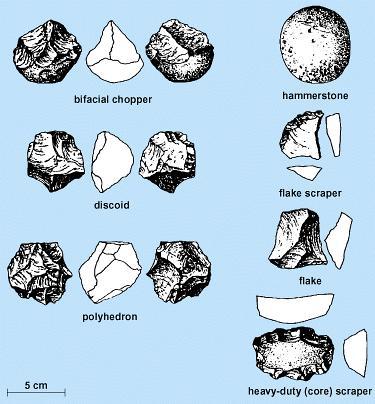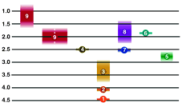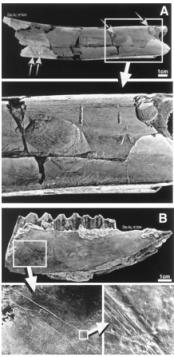 The first stone tools manufactured by our ancestors were part of the Oldowan industry. This toolkit consists of small sharp flakes which could be used for a wide range of cutting tasks. These were created by hitting a core with a hammerstone, smashing off the aforementioned flake. The core itself could also be shaped by removing flakes in from certain places, turning it into a more substantial tool which may have been used for cutting wood and other hard substances or digging up roots, tubers and other buried items.
The first stone tools manufactured by our ancestors were part of the Oldowan industry. This toolkit consists of small sharp flakes which could be used for a wide range of cutting tasks. These were created by hitting a core with a hammerstone, smashing off the aforementioned flake. The core itself could also be shaped by removing flakes in from certain places, turning it into a more substantial tool which may have been used for cutting wood and other hard substances or digging up roots, tubers and other buried items.
These stone tools were first found at Olduvai Gorge in Tanzania (from which the Oldowan derives its name) which dates to ~1.75 million years ago. The tools were found in association with the remains of Homo habilis and Paranthropus bosei. Given that the former belongs to the only genus known to make stone tools and the technology persists long after the Paranthropines went extinct everyone concluded that Homo habilis was the most likely manufacturer of these stone tools. The name of H. habilis itself is even a tribute to this fact, being latin for “handy man.”

Assorted Oldowan tools. Some may simply have been bi-products of the manufacturing process and not actual tools.
However, subsequent discoveries of the Oldowan have pushed back the date for its appearance from 1.75 million years ago to 2.5 million years ago. The “new” oldest site is Gona, Ethiopia. Conversely the oldest finds of Homo habilis are only 2.33 million years old. Whilst its possible that there are older specimens we have yet to find, this also raises the intriguing possibility that stone tools were first manufactured by an earlier species. Further, since Homo habilis is the oldest member of Homo this means that stone tools may have been manufactured by the Australopithecines.
The genus Australopithecus appeared ~4 million years ago and is the ancestor of Homo and thus modern humans. Despite this connection to later stone tool capable species nobody really believed that Australopithecus was capable of creating such technology. This is because they are markedly similar to apes in many aspects, with long arms, long curved fingers, short legs, small brains and they spent a lot of time in the trees (to name but a few similarities). Given that no modern ape is capable of manufacturing tools as sophisticated as even the earliest, most primitive Oldowan it was believed the ape-like Australopiths could not either.

Capuchins are brilliant.
Modern primates do use stones to extract resources from their environment, but these exploit rocks as they occur naturally. For example, Capuchin monkeys (the best primates ever) place nuts on a hard anvil and then smack them with rocks*, cracking the nuts and giving them access to the delicious center. Although this behavior is quite sophisticated – the Capuchins have learnt to dry nuts out in the sun first to soften them up – they carry out no alteration to these raw materials (like Oldowan cores), nor produce new tools from them (like Oldowan flakes). Whilst chimps in captivity can be trained to carry out these tasks the results are still markedly different from Oldowan technology being much smaller and less refined.
This difference stems from the fact that chimpanzees are quadrupeds and thus have to sacrifice some dexterity in their hands for weight bearing adaptations. Their wrist and elbow joints are less mobile than a humans’ to increase stability when they walk on their hands. Since Australopithecus was never a quadruped then they likely lacked these limitations, so tool use amongst that genus is not as implausible as once thought. Further, Australopithecus africanus appears to have developed the wider fingertips humans have ~3 million years ago. These wider fingertips increase the stability of small items you hold in a precision, pincer grip such as stone tools.

The chronological relationship of hominin taxa. Distance between them roughly correlates to anatomical similarity. Au. garhi is 4, Homo is 9
However, this anatomical evidence is merely circumstantial. Are there any more definitive associations between Australopiths and stone tools? Yes! Australopithecus garhi is one of the last Australopiths, appearing just before the emergence of Homo habilis. This close temporal association has led some to suggest that it is the ancestor of our genus, although the lack of distinct Homo-like traits make this far from certain. Nonetheless it seems to be closely related to Homo somehow (although most likely as an extinct sister lineage).
Australopithecus garhi was found at Bouri, Ethiopia, a mere 96 km from Hadar were the earliest Oldowan tools were found. Further, they’re dated to ~2.5 million years ago making them contemporary with the aforementioned tools. Oldowan tools were also found at Bouri but they were located on the surface of the site. Not being associated with any sediments they could not be dated, thus we do not know whether they are contemporary with Au. garhi. However bovid bones (“bovid” being “from the cow family”) were recovered from the same layers as the Au. garhi specimens and thus could be securely linked to them.

Some of the bones with tool marks from Bouri
These bones had cut marks on them which, when analysed under a microscope, are consistent with stone tools. There were also percussion scars, consistent with the bones being hit with hammer stones. A femur from a horse species was found nearby that also had similar stone tool damage, consistent with hominins dismembering and filleting the leg. As such these bones provide conclusive evidence of hominins at Bouri using stone tools 2.5 million years ago. And the only hominins we know of living at Bouri at this time is Australopithecus garhi.
When dealing with the “first” occurrence of something in the fossil/archaeological record there is always a great deal of uncertainty because we can never be sure we have actually found the oldest example. Evolutionary anthropologists may find an older Homo habilis tomorrow, or even older examples of the Oldowan may be found that associate it with an early Australopith; we simply cannot know. However this association provides significant evidence of Australopithecus making stone tools and so I have no problem saying that Australopiths most likely made the first stone tools. The current evidence we have supports it and I predict subsequent evidence will continue to justify this claim.
This discovery shows that the Australopiths weren’t quite as primitive as some once believed and raises questions about whether chimps are an effective model for our ancestors. Most importantly, this find serves to blur the distinction between Homo and Australopithecus even more. Stone tools, once thought to be one of the defining attributes of our species, were likely first made by our more ape-like ancestors. Does that make us more ape-like or the Australopiths more human? Regardless this revolutionises our understanding of technological evolution.
de Heinzelin J, Clark JD, White T, Hart W, Renne P, WoldeGabriel G, Beyene Y, & Vrba E (1999). Environment and behavior of 2.5-million-year-old Bouri hominids. Science (New York, N.Y.), 284 (5414), 625-9 PMID: 10213682
*There’s a version of this video without Atteborough. It’s rubbish.

